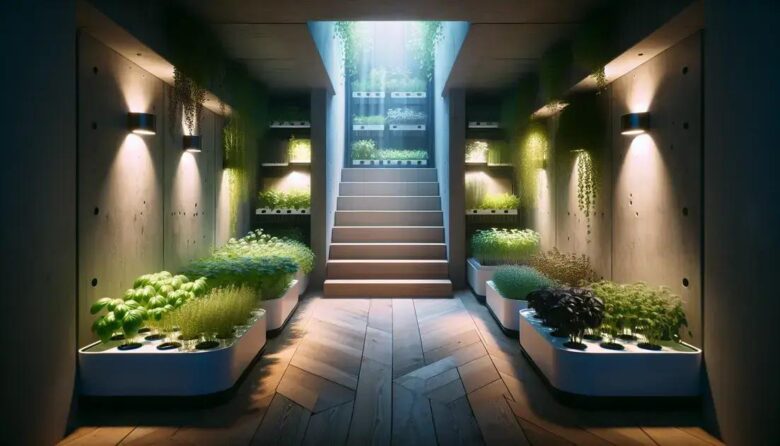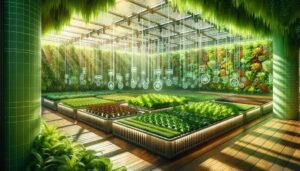Hydroponic herb gardening in basements requires careful selection of low-light herbs such as mint, parsley, and chives, alongside maintaining stable temperatures, proper LED lighting, and balanced nutrient solutions to ensure thriving growth and high yields.
Herbs can flourish in hydroponic systems even in the low-light conditions of a basement. Ever wondered how to set up such a garden in your own home? With the right strategies, you can maintain a thriving herb garden all year round. Let’s dive into the world of hydroponics and explore how you can get started today.
understanding hydroponic systems for herbs
Hydroponic systems offer a unique way to grow herbs without soil, using nutrient-rich water solutions instead. This approach allows for more control over the growing environment, leading to faster growth rates and a higher yield. There are several types of hydroponic systems to consider.
Ebb and Flow System
The ebb and flow system, also known as the flood and drain system, involves periodically flooding the grow trays with nutrient solution and then draining it back into the reservoir. This system is efficient for herbs, providing their roots with the necessary nutrients while ensuring ample oxygenation.
Nutrient Film Technique (NFT)
The Nutrient Film Technique is another popular method, where a thin film of nutrient solution continuously flows over the roots of the plants. This constant flow allows herbs to absorb nutrients effectively while being exposed to oxygen, promoting healthy growth.
Drip System
In a drip system, nutrient solution is delivered directly to the base of each plant through a series of tubes and drip emitters. This method offers precise control, ensuring each herb receives an optimal amount of nutrients and water.
Wick System
Ideal for beginners, the wick system uses a wick to draw nutrient solution from the reservoir to the plant roots. While simple and inexpensive, it might not deliver nutrients as efficiently as other systems, making it more suitable for smaller herbs.
choosing the right herbs for low-light conditions
Choosing the right herbs for low-light conditions can make a significant difference in the success of your hydroponic garden. Some herbs naturally thrive in dimmer environments, making them ideal for basement settings. Selecting these varieties ensures robust growth even when sunlight is limited.
One of the best herbs for low-light conditions is mint. This hardy plant is not only easy to grow but also versatile in its uses, from teas to cooking. Another excellent choice is parsley, a herb that does well with minimal light and offers a fresh taste to dishes. Cilantro is also a great option, as it can grow well in partial shade, adding a distinctive flavor to salsas and salads.
For beginners, consider incorporating chives into your garden. They are resilient and adapt well to less-than-ideal light conditions. Lemon balm is another herb that flourishes in low-light settings, perfect for adding a citrus flavor to dishes and beverages.
By selecting herbs suited for low-light, you ensure that your hydroponic system remains productive and your herbs remain healthy. This strategic choice helps maintain a successful indoor garden all year round.
setting up your basement hydroponic garden
Setting up your basement hydroponic garden can be a straightforward process with the right guidance. Start by selecting an area in your basement that has enough space for your system and is easy to access. Ensure there is a reliable source of electricity nearby to power lights and pumps. The temperature in the basement should be moderately stable to favor plant growth. If needed, use heaters or fans to maintain optimal conditions.
Next, choose your hydroponic system. Popular choices include NFT (Nutrient Film Technique) or ebb and flow systems. These are ideal for herbs as they provide efficient nutrient delivery and aeration. Assemble your chosen system by following the manufacturer’s instructions, ensuring all components are securely fitted.
Lighting is crucial in a basement garden. Use LED grow lights that mimic natural sunlight. Position them about six inches above the plants, adjusting as they grow. Consider lights with full-spectrum features to support different growth stages.
Fill your system’s reservoir with a nutrient solution specifically designed for hydroponics. Ensure the pH level is balanced between 5.5 and 6.5 for optimal nutrient uptake. Regularly monitor the nutrient levels and top up the solution as required.
Keen monitoring is essential in this environment. Check your plants regularly for signs of pests or disease and address any issues promptly. With careful setup and monitoring, your basement hydroponic garden can thrive all year long.
maintaining optimal conditions for growth
Maintaining optimal conditions for growth in your hydroponic garden is key to ensuring a bountiful harvest. Start by regulating the temperature in your growing space. Herbs typically prefer temperatures between 65°F and 75°F, so use heaters or fans to stabilize the environment if needed.
Light is another crucial factor. Even in a basement setup, herbs need at least 12-16 hours of light a day. Utilize LED grow lights to mimic natural sunlight and adjust the height as plants grow to provide adequate light exposure.
Monitor the humidity levels, keeping it within the 50-70% range. Too much moisture can lead to mold, while too little can dry out your plants. A small humidifier or dehumidifier can help maintain balance.
Ensure that your nutrient solution is optimal. Check the pH levels regularly, keeping them between 5.5 and 6.5 for herbs, to ensure efficient nutrient uptake. Refill the nutrient mix weekly to maintain freshness and potency.
Finally, keep an eye on your water quality. The solution should be oxygenated, so consider using an air pump to enhance oxygen levels. Consistent checks and adjustments help create a thriving environment for your herbs.
common challenges and how to overcome them
While growing herbs hydroponically in a basement can be effective, several common challenges might arise. Temperature fluctuations are a frequent issue that can stress plants. Ensure your growing environment is equipped with heaters or fans to stabilize the temperature around 65°F to 75°F.
Pest and mold problems can also occur, even in indoor setups. Regularly inspect your plants and use natural remedies like neem oil or insecticidal soap to manage these issues without harming your herbs.
Nutrient imbalances are another concern. It’s crucial to monitor the pH levels regularly and adjust your nutrient solution to keep it between 5.5 and 6.5. This balance ensures your herbs receive optimum nutrition.
Lighting problems may affect growth too. Use LED grow lights and check their intensity and coverage to simulate natural sunlight effectively. Make sure the lights are not too far from or too close to the plants.
Water quality is vital. Ensure that your nutrient solution is well-oxygenated to avoid root rot. An air pump can help increase oxygen levels, making nutrients more accessible to plant roots.
Addressing these challenges promptly helps maintain a healthy hydroponic garden and supports continuous herb production.
harvesting and using your hydroponically grown herbs
Harvesting your hydroponically grown herbs at the right time ensures maximum flavor and freshness. Most herbs are best harvested in the morning after the dew has dried but before the heat of the day affects their essential oils. For leafy herbs like basil, mint, and parsley, use sharp scissors to snip the leaves just above a set of leaves to encourage bushy growth.
For woody herbs like thyme and rosemary, cut individual sprigs just as they’re beginning to bloom. It’s crucial to leave some foliage on the plant to allow for continued growth. Regularly harvesting herbs not only provides you with fresh produce but also promotes healthier plants.
Once harvested, herbs can be used fresh or preserved. Drying is a popular method for preserving herbs, as it concentrates their flavor. Tie small bunches of herbs with a string and hang them upside down in a cool, dry place. Alternatively, freezing herbs in olive oil or water in ice cube trays can help retain their flavor for use in cooking.
Incorporate your herbs into everyday cooking. Fresh basil and mint are perfect for salads and drinks, while thyme and oregano enhance the flavors of savory dishes. Experimenting with your homegrown herbs can elevate your culinary creations.
Bringing it all together: your hydroponic journey
Growing herbs hydroponically in a basement can be a rewarding and efficient way to enjoy fresh flavors year-round. By selecting the right herbs for low-light conditions and maintaining optimal growing conditions, you can maximize your garden’s potential.
Overcoming common challenges, such as controlling temperature and ensuring proper lighting, helps your plants thrive. Regularly harvesting and experimenting with fresh herbs can enhance your culinary experiences.
With dedication and the right setup, your hydroponic garden not only provides nutritious herbs but also becomes a sustainable hobby that enriches your lifestyle. Dive into the world of indoor gardening and see your efforts bloom!
FAQ – Frequently Asked Questions About Hydroponic Herb Gardening in Basements
What are the best herbs for low-light conditions?
Mint, parsley, cilantro, chives, and lemon balm thrive in low-light conditions, making them ideal for basement hydroponic gardening.
How do I maintain temperature in a basement hydroponic setup?
Use heaters or fans to keep the temperature between 65°F and 75°F. Monitoring the environment regularly is essential.
Why is lighting important for hydroponic herbs?
LED grow lights mimic natural sunlight, essential for photosynthesis and optimal growth, especially in low-light areas like basements.
How often should I check nutrient levels in my hydroponic garden?
Regularly monitor and adjust the pH of your nutrient solution, aiming for a range of 5.5 to 6.5 to keep herbs healthy.
What common pests should I watch out for?
Indoor herb gardens may face pests like aphids and spider mites. Regular inspection and natural remedies like neem oil can help manage them.
How can I preserve herbs after harvesting?
Herbs can be dried by hanging them upside down or frozen in ice cube trays, preserving their flavor for future use.



